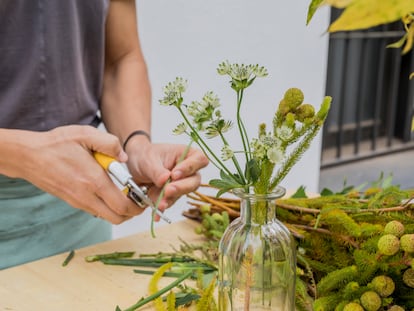Six plants that will stop you being a ‘plant killer’
Zamioculcas, spathiphyllum, and sansevieria are among a careful selection of botanical species that can deal with almost any adversity and are easier to care for than a cactus

In the world, according to approximate data, there are about 300,000 species of plants. The number of people who consider themselves plant killers remains to be counted, but, making rough estimate lacking in any scientific rigor, there are far more than there should be. And with 300,000 species, it would be almost unheard of if there was not one plant that, under normal conditions and with a little care, could survive even in the hands of a self-declared “cactus killer.”
“More plants die from excess watering than from drying out,” says Santiago González, director of the Spanish Association of Garden Centers (AECJ), and he is quite categorical about it. This is a constant refrain among experts, and most of the time it stems from such a fear that the plant will die that we take excessive care of it and that is exactly what kills it. We care too much. “The plant with a lack of water will recover, but when it has too much, it is impossible,” says Manuel Silvosa, from Silvosa Hermanos.
González gives simple advice to avoid this: “Poke your finger about an inch into the soil and see if it is dry. If you notice a little moisture, wait a few days to water.” In addition to that, he recommends one transplant per year, especially in March or April or, alternatively, “remove a finger of soil from the top and add new substrate. Mix it a little and this gives the plant a lot of nutrients.” Finally, it is a good idea to feed the plant every one or two months. There are countless liquid fertilizers on the market that you can mix with water. It is important to follow the instructions because, again, going overboard does more harm than good.
And once you have got a handle on the three basic elements of caring for any plant, what species should you choose? González warns: “We’re seeing more and more people selling very special, very rare plants online... these mini plants, if you don’t know or have only a little knowledge about them, they die. They are difficult to look after.” Common sense prevails here. A species native to the Brazilian jungle and accustomed to 85% humidity, is not going to have an easy time in an interior apartment in the center of Arizona.
So, after asking the experts, here is a careful selection of perfect plants to get rid of your plant killer label.
Zamioculcas
This plant is considered one of the hardiest in existence. Its origins in Africa can be seen in the fleshiness of its leaves, which act as water reserves. This is something that tells us that its water needs are not many. In fact, it is one of the plants that best tolerates drought. “You hardly have to water it and even in summer you can go on vacation for two or three weeks without watering it and the plant would be fine when you return,” says Silvosa. And as for light, it adapts well to the amount you have. Of course, it is better to avoid direct sun.

Spathiphyllum
Also called Peace Lily, it is a perennial plant with beautiful white flowers and very few needs. It can be a wonderful plant to improve your gardening skills, because the better we take care of it, the more it flowers and above all because, as Silvosa explains, “this plant communicates. When it needs water, its leaves droop.” Even so, be careful again with overwatering it: when you see the plant is a little wilted, you should water it normally, and not add excess water. “After a couple of hours it reacts and recovers its natural state,” says Silvosa.
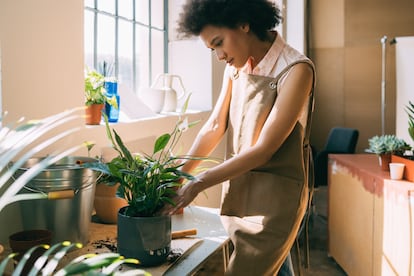
Pothos
A classic among classics. This is another plant of tropical origin that has adapted to more temperate climates, giving rise to a wonder for first-timers. Like the plants above, it is only advisable to water the plant when the substrate is dry because if you water it too much, its leaves begin to show yellow spots. It is a little more demanding in terms of light, but nothing serious. It can get by with indirect light. And the best part about the Pothos is “You can take cuttings, put them in water and the roots come directly out of the stem,” says González. With Pothos, you can go from plant killer to giving cuttings to friends. There’s a reason they were our grandmothers’ favorite plants.
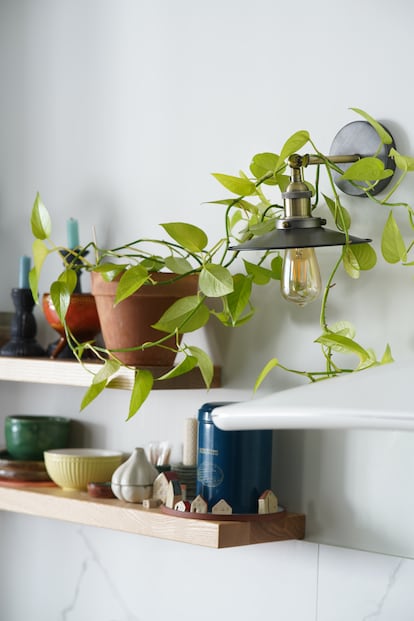
Sansevieria
“It hardly requires any water, it lasts weeks without watering. It can even survive the winter, from October to March, if you don’t want to add a drop of water, the plant will not die,” says Silvosa. This is Sansevieria or Mother-in-law’s Tongue, a plant that you can forget about. In fact it is almost the best thing you can do for it. It likes indirect light, but if it doesn’t have much, the only thing that will happen is that it will grow more slowly and put out fewer leaves. Furthermore, Sansevieria, like Potus and Spathiphyllum, is a purifying plant, according to a study that NASA carried out in 1989. In 2015, the BBC confirmed with one of the authors of the study that their conclusions were still valid.
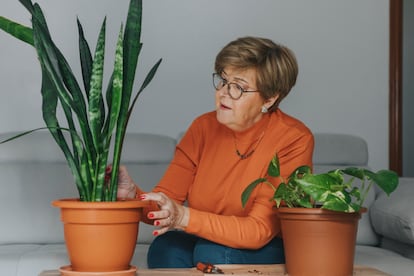
Anthurium
Anthurium is one of the hardiest flowering plants. If it has good, indirect light, it will show off with more vivid colors and you can enjoy its flowers for longer. It should be noted that what many believe are flowers of striking red, yellow, or white are actually leaves that protect the real flower. Like all the plants in this list, do not water until the substrate is dry. If the ambient humidity is low, spraying it with water may be more appreciated than watering it.
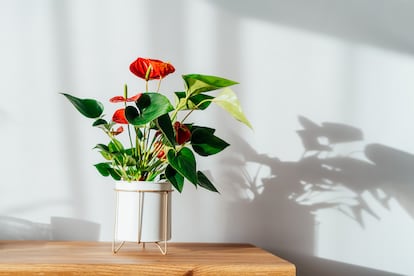
Spineless yucca
Its peculiar appearance and perennial nature make the spineless yucca a very decorative option that hardly needs any care. “They are very strong because the entire trunk is a water reserve, so if they are watered very little, they still work very well,” explains González. As for light, here is a plant that does appreciate direct sun. If it does not have enough light, it will grow more slowly and the color of its leaves may lose some vibrancy, but if it has good light and is transplanted when needed, it can grow quite a bit and become quite the showpiece.
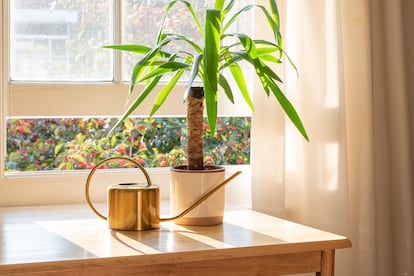
Sign up for our weekly newsletter to get more English-language news coverage from EL PAÍS USA Edition
Tu suscripción se está usando en otro dispositivo
¿Quieres añadir otro usuario a tu suscripción?
Si continúas leyendo en este dispositivo, no se podrá leer en el otro.
FlechaTu suscripción se está usando en otro dispositivo y solo puedes acceder a EL PAÍS desde un dispositivo a la vez.
Si quieres compartir tu cuenta, cambia tu suscripción a la modalidad Premium, así podrás añadir otro usuario. Cada uno accederá con su propia cuenta de email, lo que os permitirá personalizar vuestra experiencia en EL PAÍS.
¿Tienes una suscripción de empresa? Accede aquí para contratar más cuentas.
En el caso de no saber quién está usando tu cuenta, te recomendamos cambiar tu contraseña aquí.
Si decides continuar compartiendo tu cuenta, este mensaje se mostrará en tu dispositivo y en el de la otra persona que está usando tu cuenta de forma indefinida, afectando a tu experiencia de lectura. Puedes consultar aquí los términos y condiciones de la suscripción digital.
More information
Últimas noticias
Reinhard Genzel, Nobel laureate in physics: ‘One-minute videos will never give you the truth’
Pinochet’s victims grapple with José Antonio Kast’s rise in Chile
How Japan is trying to avert ‘digital defeat’
The complicated life of Francesca Albanese: A rising figure in Italy but barred from every bank by Trump’s sanctions
Most viewed
- Pablo Escobar’s hippos: A serious environmental problem, 40 years on
- Why we lost the habit of sleeping in two segments and how that changed our sense of time
- Charles Dubouloz, mountaineering star, retires at 36 with a farewell tour inspired by Walter Bonatti
- Trump’s obsession with putting his name on everything is unprecedented in the United States
- The Florida Keys tourist paradise is besieged by immigration agents: ‘We’ve never seen anything like this’


